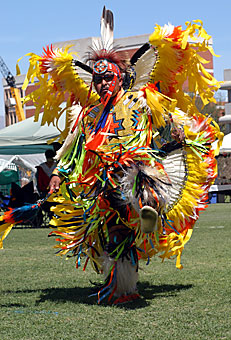 |
|
MELISSA HALTERMAN/Arizona Daily Wildcat
|
A powwow participant enters Bear Down Field Saturday afternoon as part of the grand entry. After the entrance, people from many tribes played in a drum circle and held dancing competitions, celebrating American Indian culture.
|
|
|
By Mitra Taj
Arizona Daily Wildcat
Monday, March 29, 2004
Print this
Famous powwow drumming, colorful costumes, and American Indian dance performances drew people from across the country to campus Friday and Saturday to participate in the second annual UA Wildcat Powwow.
"For a lot of Native American students, it's a way of getting together and celebrating being native," said Shawn Bitsuie, a pre-veterinary science senior who has been singing and drumming with Panther Creek, the gourd drum group at the powwow for two years.
About 1,000 people filled Bear Down Field during the two-day event, said Lee Jackson, president of the UA Powwow Committee and American Indian studies graduate student. The committee revived the UA powwow last year and has been working year-round to raise money for the event.
"It's as much for campus as it is for the community. It's a celebration to share cultural heritage," said Jackson, a member of the Chumash tribe of southwestern California.
Justin Haynes, a sociology and religious studies sophomore who is Choctaw, said it was only his second time at a powwow.
"It's a way of keeping in touch with my Native American side," Haynes said.
"It brings diversity to campus and you meet new people," said Tondalia Brown, a former Miss Native American and aerospace engineering junior. "You learn from other tribes too."
Diversity among the Native Americans in attendance could be seen from the different dance categories and drum groups. Jackson said members from at least 15 tribes were present.
This year, the committee brought two of the United States' best drum groups, a big draw for many who went to the powwow.
"When the Indian community hears that there is a big drum coming, they like to come out and see them," said Jackson.
Omaha White Tail, the southern drum group from Nebraska, and Black Lodge, the northern drum group from Washington, alternated playing for the dancers with other groups. Each group circled around a big drum they beat while they sang. The circles of drum groups formed a bigger circle around the dancers, who displayed their elaborate, homemade costumes as they moved.
Jackson said the singing often alluded to battles and why they must be fought, or praised the dancers. Intertribal songs relied on "vocables," or chanting, instead of words.
"You don't really get that kind of singing anywhere else around here," said Bitsuie of the Tucson drum group Panther Creek.
He described his experiences drumming and singing as "spiritual and uplifting."
"There's a certain feeling I get when I sing. ... It's molded one aspect of my life," Bitsuie said.
Bitsuie described himself and other members of the Navajo tribe as "diné," a word meaning "the people." He said his parents don't sing and dance powwow, but he and his brother became interested in it when they were teenagers. He said he thinks other young American Indians would benefit from participating in events.
"It gives them a direction toward finding out more about themselves," said Bitsuie. "Just being proud of being native."
The group members, who practice year-round and perform at other American Indian events on and off campus, learn to sing in languages other than their native tongue, such as Cherokee, Navajo and Pawnee.
The group's elder and one of its lead singers, Thomas Holm, professor of American Indian studies, said there are about 500 American Indian students at the university.
"(The powwow) is a chance for them to feel good about themselves," he said.
Bijiibaa' Garrison, a nutritional sciences and community health education senior, introduced herself in Navajo and in English Saturday as the winner of the 1999-2000 Miss Native American.
Garrison said she will serve as a representative of the American Indian community at the university and will be its link to the off-campus community.
She also said she will promote raising American Indian graduation and retention rates, which she said were the lowest among all other groups in the university.
Antonio Blueeyes, a computer engineering major at New Mexico State University traveled from Las Cruces, N.M., with other members of the northern-style powwow singing group, Black Eagle.
"We sing because we see happy people and we sing for the dancers and the arena," Blueeyes said.
Black Eagle won a Grammy this year for Best Native American Recording for its album Flying Free.
About 100 contestants danced in categories showcasing different dance styles and age groups - from the young to the young at heart.
American Indian fry bread and tacos, jewelry, dream catchers and T-shirts were sold at the powwow.
